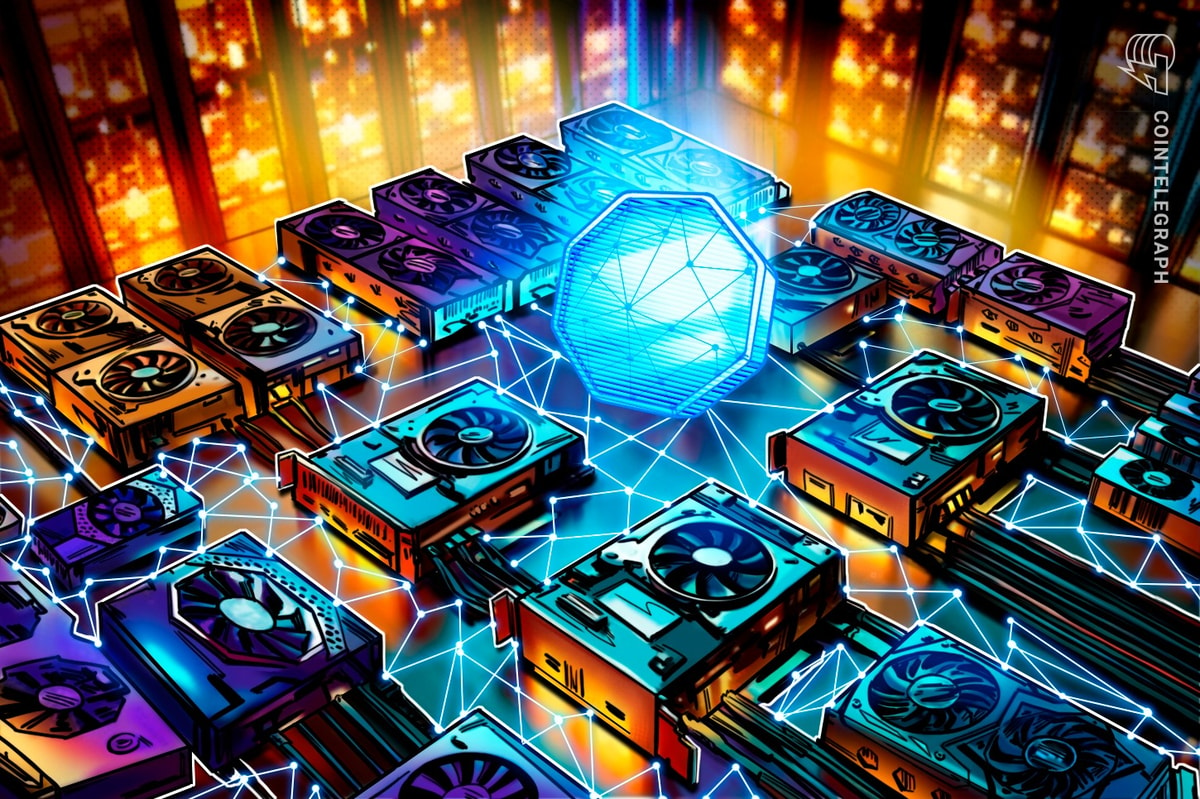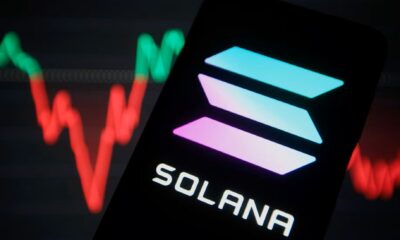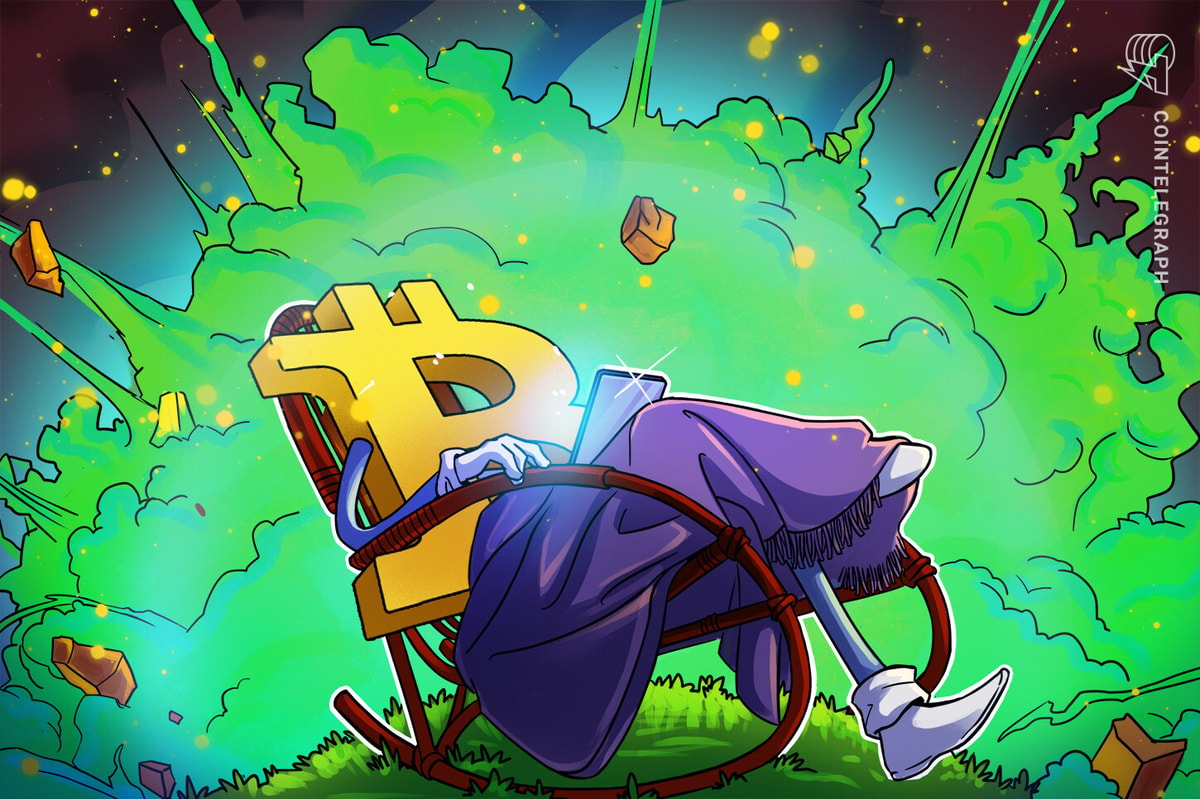Uncategorized
How to use Render Network for decentralized GPU rendering
Published
7 days agoon
By
admin
Key takeaways
Render Network connects GPU owners with creators, allowing users to rent idle graphics power for AI training, 3D rendering and crypto-related projects.
The RNDR token powers the ecosystem, enabling fast, transparent and decentralized transactions between creators and node operators.
Decentralized rendering is more accessible and cost-effective than traditional centralized GPU services, solving issues such as pricing, scalability and vendor lock-in.
Proof-of-render ensures verified outputs, rewarding only completed, validated tasks while maintaining blockchain-level trust and transparency.
The hunger for powerful graphics processing units (GPUs) has skyrocketed. Whether it’s training complex AI models or rendering high-fidelity 3D graphics, the demand often outstrips supply.
Traditional centralized GPU services, while effective, can be costly and sometimes inaccessible to smaller developers or artists. This is where the Render Network steps in, offering a decentralized approach to GPU rendering.
By connecting individuals who have idle GPU power with those who need it, Render Network creates a collaborative ecosystem that benefits both parties. This not only democratizes access to high-performance computing but also introduces a crypto-economic model, utilizing its native RNDR token to facilitate transactions.
In the sections that follow, you’ll learn how Render Network is contributing to the evolution of AI development and 3D rendering through decentralization and blockchain technology.
What is Render Network?
At its core, Render Network is like an Airbnb for GPU power. If you’ve got a powerful graphics card sitting idle, you can rent it out. And if you’re someone building an AI model or rendering a complex 3D scene but don’t have enough GPU muscle, you can tap into that unused power — on demand.
Here’s how it works:
Creators
These are the people who need serious computing power — think AI researchers training models, 3D artists rendering animations or developers working on visually demanding projects. Instead of buying expensive hardware or paying top dollar for centralized cloud services, they can just hop on Render Network and get access to what they need when they need it.
Node operators
On the flip side, there are folks who have GPUs collecting dust (or at least not being fully used). Maybe it’s a gaming rig that’s idle during work hours or a small mining setup looking for a better use case. These operators can plug into Render Network, offer up their GPU power, and earn crypto — specifically RNDR tokens — for their trouble.
RNDR token
The RNDR token (RNDR) is the fuel that keeps this whole ecosystem running. It’s the currency used to pay for jobs on the network. Creators pay in RNDR; operators earn in RNDR. Everything happens transparently onchain, and the token system helps keep things fair and efficient.
In short: Creators get access to affordable, decentralized computing power; node operators get rewarded for sharing their resources; and RNDR tokens make it all tick. It’s a win-win setup that’s especially useful in AI and crypto-heavy workflows.
Did you know? Render Network employs blockchain technology to ensure that every transaction and rendering task is securely recorded, promoting transparency and trust among users.
The role of decentralization in GPU rendering
If you’ve ever tried renting GPU power from a big cloud provider, you know it can get expensive fast. And even then, you’re often competing with major corporations for access to the best hardware. The whole system works, sure, but it’s not exactly built with flexibility or accessibility in mind.
That’s where decentralization comes in. Render Network flips the script by spreading the workload across a global network of independent GPU owners. Instead of relying on a single provider, you’re tapping into thousands of available machines — from gaming rigs to pro-grade render farms — that might otherwise sit idle.
What’s the problem with centralized GPU rendering?
Centralized services come with a few key headaches:
It’s pricey: Renting powerful GPUs from the likes of Amazon Web Services or Google Cloud can eat through your budget quickly, especially if you’re running long jobs like training an AI model.
Scalability is limited: If you suddenly need more power, scaling up isn’t always smooth or instant. You’re stuck waiting in line — or paying more for priority access.
Access isn’t equal: Big corporations tend to hoard the best GPU availability, which makes it harder for smaller teams or indie creators to get what they need when they need it.
Vendor lock-in is real: Once you build your pipeline around one provider, switching later can be a pain (and expensive).
Why decentralization makes more sense
Now, here’s what a decentralized network like Render offers instead:
Lower costs: Because you’re tapping into existing resources that would otherwise be unused, pricing tends to be way more affordable.
Flexible scaling: Need more power? The network can grow with you — just pull in more nodes.
Equal access: There’s no gatekeeping. Anyone can request GPU resources, and anyone can provide them. It’s a much more level playing field.
Earn while you sleep: If you’ve got a powerful GPU, you can make it work for you by sharing it on the network when you’re not using it.
All in all, decentralized GPU rendering is quickly becoming the practical choice for AI builders, 3D artists and crypto-native developers who want more control over their tools and budget.
The crypto economy within Render Network
As you briefly explored, at the heart of Render Network’s decentralized rendering platform is its native cryptocurrency, the RNDR token. Let’s dive deeper.
RNDR token mechanics
The RNDR token serves as the primary medium of exchange within the Render Network. Creators use RNDR tokens to pay for rendering services, while node operators earn these tokens by providing their GPU power to process rendering tasks. This system creates a self-sustaining economy where computational resources are efficiently allocated and fairly compensated.
Additionally, a small percentage of RNDR tokens, ranging from 0.5% to 5%, is charged on every transaction to support the ongoing development and maintenance of the network.
Earning RNDR tokens
Once onboarded, node operators can connect their GPUs to the network and start accepting rendering jobs. After successfully completing and submitting a rendering task, the work undergoes verification to ensure quality standards are met. Upon approval, the corresponding RNDR tokens are transferred to the node operator’s digital wallet as compensation for their contribution.
Spending RNDR tokens
Creators looking to access rendering services can acquire RNDR tokens through various cryptocurrency exchanges. Once they have the tokens, they can submit their rendering projects to the network. The system calculates the required RNDR tokens based on the project’s complexity and resource demands. After the rendering is completed and the output meets the creator’s expectations, the RNDR tokens are released from escrow and transferred to the node operators who processed the job.
This token-based economy not only streamlines the transaction process within the Render Network but also fosters a collaborative environment where both creators and node operators benefit from the decentralized exchange of rendering services.
Did you know? Render Network utilizes a unique proof-of-render mechanism, which validates completed rendering tasks before compensating node operators. This system mirrors blockchain’s transaction validation processes, ensuring that only verified work is rewarded.
Getting started with Render Network
Here’s how to get started with Render Network.
For creators
Setting up an account and submitting rendering tasks require the following:
Obtain an OctaneRender license: Ensure you have an active OctaneRender license or subscription, which can be purchased from OTOY.
Access the Creator Portal: With your OctaneRender credentials, log in to the Creator Portal.
Prepare your project: Export your project as an ORBX file using OctaneRender. This format encapsulates all necessary assets and settings for rendering.
Submit your job: Upload the ORBX file to the Creator Portal, configure your rendering parameters (such as resolution and sample size), and choose a service tier that fits your needs.
Monitor and retrieve results: Once submitted, you can monitor the progress of your rendering tasks through the portal. Upon completion, download your rendered assets directly from the platform.
For node operators
Registering GPUs on the network requires:
Express interest: Complete the Render Network Interest Form to join the onboarding queue.
Await onboarding instructions: Once a slot becomes available, the Render Network team will provide further instructions for setting up your node.
By following these steps and best practices, both creators and node operators can effectively engage with the Render Network, leveraging its decentralized infrastructure for efficient rendering solutions.
A bright future for Render Network?
Render Network is quickly becoming a go-to solution for anyone needing serious GPU power — especially in AI and crypto. Decentralizing access to high-performance computing makes rendering and model training faster, cheaper and way more accessible.
What’s exciting is where it’s headed. The network is expanding to support more advanced AI workflows and exploring deeper integration with other blockchain ecosystems. That means more tools, more flexibility and even broader use cases — whether you’re building with AI, working in 3D or developing onchain applications.
At the end of the day, Render Network is creating a new kind of infrastructure where creators and GPU owners can work together, earn and scale. Whether you’re here to build or contribute, it could be a space worth jumping into.
Source link
You may like


This Week in Crypto Games: Gaming Tokens Crash Out, Eve Frontier Opens Up


Commerce Secretary Lutnick walks back tariff relief on electronics


Gold ETF Inflows Hit Three-Year High as PAXG, XAUT Outperform Wider Crypto Market


Israel’s New Study Shows 51% Of Public Is Interested In Adopting CBDC (Digital Shekel) – Is That So?


Solana Price Eyes Breakout Toward $143 As Inverse Head & Shoulders Pattern Takes Shape On 4-hour Chart


Crypto malware silently steals ETH, XRP, SOL from wallets
Uncategorized
Commerce Secretary Lutnick walks back tariff relief on electronics
Published
1 hour agoon
April 13, 2025By
admin
Commerce Secretary Howard Lutnick walked back the recent reciprocal tariff exemption on select electronics announced in an April 12 bulletin from the United States Customs and Border Protection.
On April 13, Lutnick told ABC News that the reciprocal tariff exemption was temporary until the administration established a sector tariff regime for semiconductor products, which includes phones, graphics processors, and computing chips in a “month or two.” Lutnick added:
“President Trump has called out pharmaceuticals, semiconductors, and autos. He called them sector tariffs, and those are not available for negotiation. They are just going to be part of making sure we ensure core national security items are made in this country.”
“We can’t be relying on China for fundamental things we need. Our medicines and our semiconductors need to be built in America,” Lutnick continued. The official also said he was confident that the US and China would arrive at a trade deal through negotiations.
The emphasis on national security and onshoring critical industries could signal that the trade tariffs will be a long-term geostrategic policy and not simply a short-term negotiation tactic to make US exports more attractive, as some analysts have suggested.
The Volatility S&P Index (VIX), a measure of the S&P stock index’s volatility, remains elevated amid macroeconomic uncertainty. Source: TradingView
Related: Bitcoin ‘decouples,’ stocks lose $3.5T amid Trump tariff war and Fed warning of ‘higher inflation’
Trade war heightens volatility and sends markets tumbling
Trump’s trade tariffs crashed the stock and crypto markets, wiping away trillions in shareholder value as investors dumped riskier assets on fears of a lengthy trade war between the United States and its trading partners.
In an April 10 X Post, Bloomberg analyst Eric Balchunas cited the SPY US Equity History Volume chart as evidence that the S&P 500 stock market index is now more volatile than Bitcoin (BTC).
According to the analyst, the S&P 500 Index hit a volatility level of 74 in April, compared to Bitcoin’s 71.
Stocks and crypto pumped following rumors of the Trump administration initiating a 90-day reciprocal tariff pause. Approximately $2 trillion was pumped into stocks on rumors of softer trade policies. Much of this value was then wiped away when Trump claimed that rumors of a 90-day pause were false and returned once the Trump administration did, in fact, issue a reciprocal tariff pause in the following days. Magazine: Financial nihilism in crypto is over — It’s time to dream big again Published on By Bitcoin (BTC) hit an eleven-day high on April 13 as the crypto market relief rally closely tracked US financial policy changes. BTC/USD 1-hour chart. Source: Cointelegraph/TradingView Data from Cointelegraph Markets Pro and TradingView showed BTC/USD reaching $86,000 for the first time since April 2. The pair had reacted well to news that US President Donald Trump had decided to exclude certain key products from his ongoing trade tariffs against China. Traditional markets are closed on weekends —creating lower-liquidity trading in crypto markets and raising the chance for price volatility— with Bitcoin subsequently dropping under $84,000. With hours to go until the weekly close, BTC/USD was thus up 7% for the week, having started with a trip to new five-month lows. Commenting, traders were cautious over BTC price strength. Call me crazy but I don’t think I trust this breakout on $BTC. Low volume, overbought stoch, and on a weekend. If we can remain over 84k through Monday I’ll look for higher but for now this seems sketchy. pic.twitter.com/qKVdYAOYPJ — Roman (@Roman_Trading) April 12, 2025 Daan Crypto Trades noted the ongoing interplay with the 200-day exponential moving average (EMA) at $85,000. “This is however still a weekend move so far and we know next week will be volatile again with news regarding tariffs and the first big tech earnings coming up,” part of a post on X read. BTC/USD 1-day chart with 200 EMA. Source: Cointelegraph/TradingView Well-known trader Peter described the rebound from the lows as looking “more corrective than it does impulsive.” BTC/USD 2-hour chart. Source: Peter Brandt/X Popular trader and analyst Rekt Capital meanwhile saw the true hurdle to a Bitcoin bull market rebound coming in the form of a stubborn long-term daily downtrend. “Bitcoin has Daily Closed above the Downtrend. Thus, breakout confirmation is underway,” one of his latest X updates explained alongside an illustrative chart. “However BTC has previously Daily Closed above the Downtrend but failed its retest (a few of the red circles). Retest needs to be successful and it is in progress.” BTC/USD 1-day chart. Source: Rekt Capital/X As Cointelegraph reported, the daily downtrend, in place since late 2024, is earmarked as a key hurdle for bulls to overcome. Related: Bollinger Bands creator says Bitcoin forming ‘classic’ floor near $80K Another post flagged promising signals on Bitcoin’s relative strength index (RSI) indicator. A classic leading indicator, RSI continued to print another bullish divergence with price on daily timeframes. “Bitcoin is developing yet another Higher Low on the RSI while forming Lower Lows on the price,” Rekt Capital summarized. “Overall, throughout the cycle Bitcoin has formed Bullish Divergences like this on a few occasions already. Each Bull Div preceded reversals to the upside.” BTC/USD 1-day chart with RSI data. Source: Rekt Capital/X This article does not contain investment advice or recommendations. Every investment and trading move involves risk, and readers should conduct their own research when making a decision. Published on By Crypto gaming and gambling campaigns are the most expensive way to acquire users with existing crypto wallets, ranking highest in cost among all sectors of the crypto industry, recent data shows. “Gaming and gambling campaigns are the most expensive, with a median CPW of $8.74 and a lower quartile of $3.40,” Web3 marketing firm Addressable co-founder Asaf Nadler said in a recent report posted on X. CPW, or cost per wallet, is deemed a higher “quality” metric because it tracks the cost of website visitors with a crypto wallet already installed in their browser. Nadler previously told Cointelegraph that their analysis data showed that users with a wallet are more likely to convert to crypto products. CPW across different regions during the bull markets in Q1 an Q4 of 2024. Source: Asaf Nadler Nadler said the high cost-to-return ratio of crypto gaming and gambling might be due to “higher churn, speculative behavior, and intense competition.” He added: “If Web3 gaming is truly “inevitable,” we need to find a more powerful UA engine to make it as sustainable as in Web2.” However, Axie Infinity co-founder Jeff “JiHo” Zirlin said in an April 11 post on X that periods of high CPW are a good time to experiment. “Create new games/product lines, consolidate our market share, and get ready for the next market expansion,” Zirlin said. “Know when it’s a coiling phase. Know when it’s time to explode,” he added. Meanwhile, decentralized finance (DeFi) and Centralized Finance (CeFi) campaigns have it a lot easier with attracting new crypto users. “DeFi/CeFi campaigns are the most cost-efficient, with a median CPW of $2.79 and a lower quartile of just $0.10,” Nadler said. The results are based on 200 programmatic campaigns run on Addressable by over 70 advertisers, claiming to target an estimated 9.5 million users globally. CPW results across various sectors of the crypto industry. Source: Asaf Nadler It tracks how CPW varies across market cycles, regions, campaign strategies, and audience segments. Nadler said that while premium markets experience low-cost conversions for existing crypto wallet holders during bull runs, attracting their attention becomes significantly more expensive during market downturns. Related: Trump kills DeFi broker rule in major crypto win: Finance Redefined He highlighted that in 2024, the US and Western Europe saw CPW increase by four times and 27 times, respectively, between Q1 and Q3, as the markets continued to consolidate and interest from crypto wallet holders waned. “While these markets provide scale and quality during bull runs, they become significantly more expensive when sentiment turns bearish, making them less sustainable during downturns,” Nadler said. Meanwhile, emerging markets like Latin America and Eastern Europe “offer exceptionally low CPW in favorable conditions but can experience extreme cost volatility.” Magazine: Bitcoin eyes $100K by June, Shaq to settle NFT lawsuit, and more: Hodler’s Digest, April 6 – 12 Arthur Hayes, Murad’s Prediction For Meme Coins, AI & DeFi Coins For 2025 Expert Sees Bitcoin Dipping To $50K While Bullish Signs Persist Aptos Leverages Chainlink To Enhance Scalability and Data Access Bitcoin Could Rally to $80,000 on the Eve of US Elections Crypto’s Big Trump Gamble Is Risky Sonic Now ‘Golden Standard’ of Layer-2s After Scaling Transactions to 16,000+ per Second, Says Andre Cronje Institutional Investors Go All In on Crypto as 57% Plan to Boost Allocations as Bull Run Heats Up, Sygnum Survey Reveals Ripple-SEC Case Ends, But These 3 Rivals Could Jump 500x
Source link Uncategorized
Bitcoin price tags $86K as Trump tariff relief boosts breakout odds

Bitcoin traders say brace for more volatility
RSI bullish divergence still in play
Source link Uncategorized
Crypto gaming and gambling ads ‘most expensive’ for onboarding users

“Higher churn” rate may be to blame
Premium markets cost more to reach crypto users during downturns
Source link 
This Week in Crypto Games: Gaming Tokens Crash Out, Eve Frontier Opens Up

Commerce Secretary Lutnick walks back tariff relief on electronics

Gold ETF Inflows Hit Three-Year High as PAXG, XAUT Outperform Wider Crypto Market

Israel’s New Study Shows 51% Of Public Is Interested In Adopting CBDC (Digital Shekel) – Is That So?

Solana Price Eyes Breakout Toward $143 As Inverse Head & Shoulders Pattern Takes Shape On 4-hour Chart

Crypto malware silently steals ETH, XRP, SOL from wallets

Binance Executives Met With US Government Officials To Discuss Easing of Regulatory Supervision: Report

Michael Saylor Hints At Another MicroStrategy Bitcoin Purchase, BTC Price To Rally?

From the Crypto Trenches to the Hill: Why Solana Is Making a Big Push in Washington

Bitcoin price tags $86K as Trump tariff relief boosts breakout odds

Where Top VCs Think Crypto x AI Is Headed Next

India’s Leading Bitcoin And Crypto Exchange Unocoin Integrates Lightning

Solana Triggers Long Thesis After Pushing Above $125 – Start Of A Bigger Rally?

Popcat price surges as exchange reserves fall, profit leaders hold

Crypto Analyst Says Bitcoin Back in Business, Calls for BTC Uptrend if One Support Level Holds

Arthur Hayes, Murad’s Prediction For Meme Coins, AI & DeFi Coins For 2025

Expert Sees Bitcoin Dipping To $50K While Bullish Signs Persist

Aptos Leverages Chainlink To Enhance Scalability and Data Access

Bitcoin Could Rally to $80,000 on the Eve of US Elections

Crypto’s Big Trump Gamble Is Risky

Sonic Now ‘Golden Standard’ of Layer-2s After Scaling Transactions to 16,000+ per Second, Says Andre Cronje

Institutional Investors Go All In on Crypto as 57% Plan to Boost Allocations as Bull Run Heats Up, Sygnum Survey Reveals

Ripple-SEC Case Ends, But These 3 Rivals Could Jump 500x

Has The Bitcoin Price Already Peaked?

A16z-backed Espresso announces mainnet launch of core product

The Future of Bitcoin: Scaling, Institutional Adoption, and Strategic Reserves with Rich Rines

3 Voting Polls Show Why Ripple’s XRP Price Could Hit $10 Soon

Xmas Altcoin Rally Insights by BNM Agent I

Blockchain groups challenge new broker reporting rule

I’m Grateful for Trump’s Embrace of Bitcoin
Trending


















